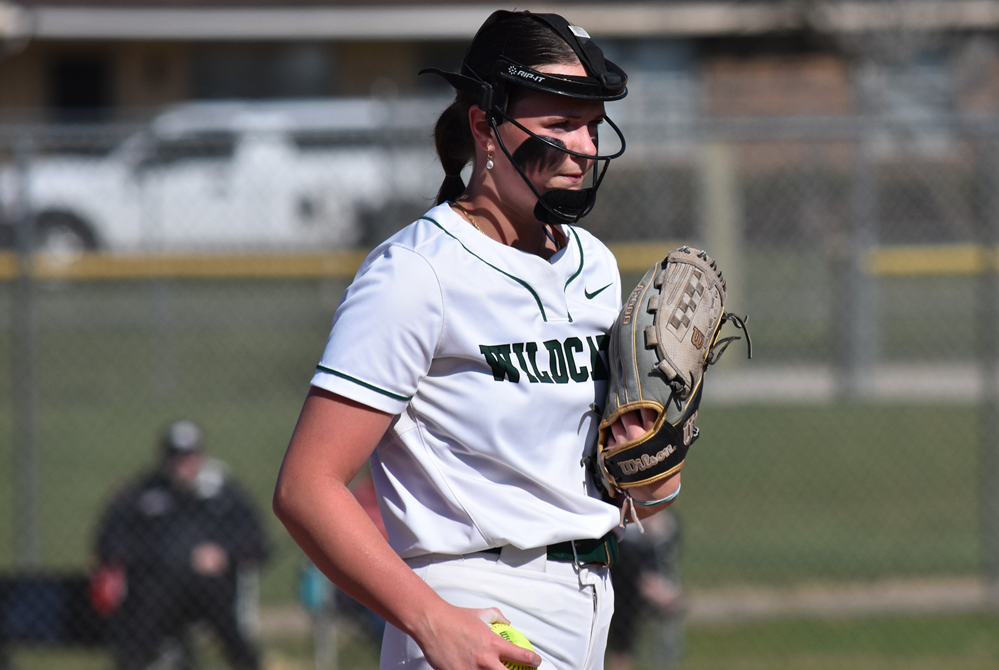
High 5s: 5/22/12
May 22, 2012
None of this week's High 5s honorees knows much about losing. Ann Arbor Pioneer's Drake Johnson is unequaled in his best race, Decatur's Erika Southworth has averaged more than 25 wins pitching each season of high school, and the Remus Chippewa Hills girls track team hasn't lost during the regular season in nearly a decade.
 Erika Southworth
Erika Southworth
Decatur senior
Softball
Southworth, a pitcher, is finishing her fourth varsity season after earning all-state honors after all of her previous three. She both won her 100th game and notched her 1,000th career strikeout last week, putting her in the MHSAA record book in both categories. Southworth is 24-3 this season with a 0.83 ERA and 199 strikeouts, and also leads her team with a .448 batting average and 35 RBI. She's signed to play next season at the University of Michigan-Dearborn and is considering a major in business. Decatur is ranked No. 7 in the state coaches Division 4 poll.
Celebrate good times: "My 100th win was at home, and they gave me a picture that said '100 wins.' It's really nice. ... My 1,000th strikeout was at Climax-Scotts, and my teammates were counting down in the dugout. I was batting one inning, and I could hear them whispering. After the strikeout, my catcher called timeout and came out and gave me a hug. Then the umpire (asked what had happened), called timeout, gave the ball to my coach and announced it to everyone on the field."
Commander-in-chief: Southworth is her class' president and has been part of the student council and National Honor Society. "I like being involved with my class. I've gotten to know a lot of people that I wouldn't usually talk to in a regular school day."
I learned the most about pitching from: One of my high school teammates from a couple of years ago (Kelsey Vliek), her dad (Jeff) got me into it. After that, I just played travel ball, and my coach would help. Then I just went to different pitching coaches."
Competing with Cole: Southworth has a fun rivalry with little brother Cole, a freshman wrestler and baseball catcher. "We both take strength and conditioning at school, different hours but we do the same lifts. So we try to beat each other that way. ... This year is the first year I've ever pitched to him. I always told my mom it wasn't a good idea. I'd just aim for his face all the time."
The ball starts here: "I like that I start out every play. The pitcher kinda controls the game, controls the pace of the game. I like knowing where most of the balls are going to be hit. (And) I think it's more of a challenge. I always go for more of the challenging things."
 Drake Johnson
Drake Johnson
Ann Arbor Pioneer senior
Track and Field
Johnson, who has signed to play football this fall at the University of Michigan, is a two-time MHSAA Division 1 champion in the 110-meter hurdles, and won both that race (14.25) and the 300 hurdles (38.63) at Friday's Division 1 Regional at Saline. He also ran on the second-place and state-qualifying 1,600 relay and on the third-place 800 relay. Johnson owns the Pioneers' record in the 110 hurdles of 13.7 seconds. Last fall as a running back, he was tops in the state with 2,809 yards rushing, sixth in the MHSAA record book for one season. He also is interested in running track at U-M.
Loving both for different reasons: "I like the thrill of football. I love the games, the scoring, the hype around football. Track, it's just the competitiveness of one-on-one. It's your best effort against their best effort."
I learned the most about running from: "I've always had my coaches at Pioneer, and my dad (Michael Johnson) has always been my hurdles coach. If I feel like I'm not running as well as I can, I can say, 'Hey dad,' and he'll say come to the track a couple times and we can fix it."
As a running back, I try to be like: "Not a single person, but a combination of Tyrone Wheatley and Eric Dickerson. Just watching videos with my dad, I got interested in seeing what (Dickerson) ran like. He really was amazing at what he did."
My favorite thing to do that isn't a sport is: "I love watching movies. Any movie I can find. I love the 'Pirates of the Caribbean' movies, and I love the 'Oceans' (Eleven, Twelve, etc.) movies."
Up next: Johnson will major in philosophy and psychology, and eventually wants to be a psychiatrist. "Just knowing how people think. ... I always tried to see things from other people's points of view. I'm an open-minded person, and (I enjoy) the whole study of trying to see how people think."
 Remus Chippewa Hills girls track and field
Remus Chippewa Hills girls track and field
Heading into last week, the Warriors were riding a 74-dual meet win streak, and edged Mount Pleasant by 1.5 points to win their Division 2 Regional on Friday. Chippewa Hills, competing in the Central State Activities Association tonight, also won its 10th-straight league championship meet Tuesday. Most of the Warriors are underclassmen -- the team has only one senior.
This spring's previous honorees
- Sarah Appold, Saginaw Valley Lutheran softball
- Katie Brozovich, Clarkston tennis
- Sarita Dotson, Battle Creek Lakeview track and field
- Lauren Hooker, East Grand Rapids senior
- Jake McFadden, Clare track and field
- Mike Nagy, Manistique golf
- Cullen Prena, Walled Lake Central track and field
- Nick Stiles, Bath baseball
- Malloy Weber, Northville soccer
- Garret Zuk, White Lake Lakeland track and field
- Detroit Western International baseball
- Grand Rapids West Catholic golf
- Grosse Pointe South girls track and field
- Muskegon Mona Shores golf
- Stevensville Lakeshore softball

Performance of the Week: Jenison's Alli Wright
April 18, 2024
 Alli Wright ♦ Jenison
Alli Wright ♦ Jenison
Junior ♦ Softball
The Wildcats’ ace opened her junior season last week with a 2-0 shutout over Cedar Springs, during which she struck out 19 batters and went over 500 for her career. She followed that up with a 12-2 win over Division 2 No. 2 Vicksburg and also has victories over Caledonia and Holland West Ottawa as Jenison has opened 7-0 and ranked No. 3 in Division 1.
Wright earned all-state honorable mention last season for the second time after pitching the Wildcats to the Division 1 Quarterfinals. She quickly set the tone for her high school career as a freshman, setting the program’s single-season strikeout record that spring. She’s also set up for when her Jenison career is done – she’s committed to continue playing softball at Grand Valley State.
@mhsaasports 🥎POW: Alli Wright #softball #jenison #letsgo #strikeout #part1 #highschoolsports #tiktalk #interview #performanceoftheweek #mistudentaid #fyp #MHSAA ♬ original sound - MHSAA
@mhsaasports 🥎POW: Alli Wright #tiktalk #questiontime #part2 #swedishfish #chickfila #princessandthefrog #dancemoms #pineappleonpizza #performanceoftheweek #mistudentaid #fyp #MHSAA ♬ original sound - MHSAA
Follow the MHSAA on TikTok.
MHSAA.com's "Performance of the Week" features are powered by MI Student Aid, a division within the Department of Lifelong Education, Advancement, and Potential (MiLEAP). MI Student Aid encourages students to pursue postsecondary education by providing access to student financial resources and information. MI Student Aid administers the state’s 529 college savings programs (MET/MESP), as well as scholarship and grant programs that help make college Accessible, Affordable and Attainable for you. Connect with MI Student Aid at www.michigan.gov/mistudentaid and find more information on Facebook and Twitter @mistudentaid.
Past 2023-24 Honorees
April 11: Chloe Wishart, Trenton soccer - Report
March 28: Jenna Maki, Ishpeming basketball - Report
March 22: Jaremiah Palmer, Niles Brandywine basketball - Report
March 15: Leah Hodge, North Farmington gymnastics - Report
March 8: Darius Marines, Detroit Catholic Central wrestling - Report
March 1: Rylee Smith, Zeeland West bowling - Report
Feb. 22: Caleb Lewandowski, Traverse City West skiing - Report
Feb. 15: Jadin Mix, Onaway basketball - Report
Feb. 8: Onalee Wallis, Cadillac skiing - Report
Feb. 1: Abbey DeGraw, Rochester Hills Stoney Creek competitive cheer - Report
Jan. 25: Ewan Todd, Riverview swimming - Report
Jan. 18: Ashley Weller, Jackson Northwest basketball - Report
Jan. 11: Michael Baldwin, Saginaw Arthur Hill wrestling - Report
Dec. 15: Jena Fijolek, Fenton bowling - Report
Dec. 8: Sophia Wagner, Escanaba gymnastics - Report
Dec. 1: Isaiah Marshall, Southfield Arts & Technology football - Report
Nov. 24: Sarah Bradley, Clarkston Everest Collegiate volleyball - Report
Nov. 17: Kalieb Osborne, Waterford Mott football - Report
Nov. 10: Tekalegn Vlasma, Muskegon Western Michigan Christian soccer - Report
Nov. 3: Colton Kinnie, Birmingham Seaholm football - Report
Oct. 27: Lauren Timpf, Macomb Lutheran North golf - Report
Oct. 20: Alena Li, Okemos golf - Report
Oct. 13: Seth Norder, Grand Haven cross country - Report
Oct. 5: Paige Anderson, Muskegon Reeths-Puffer golf - Report
Sept. 29: MacKenzie Bisballe, Lake City volleyball - Report
Sept. 22: Jhace Massey, Gladwin football - Report
Sept. 15: Kaylee Draper, Sturgis swimming - Report
Sept. 8: Owen Jackson, Traverse City St. Francis tennis - Report
Sept. 1: Rachel Forsyth, Ann Arbor Pioneer cross country - Report
(Photos courtesy of the Wright family.)

